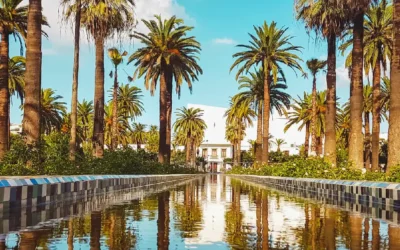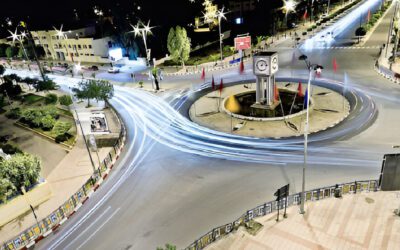Morocco
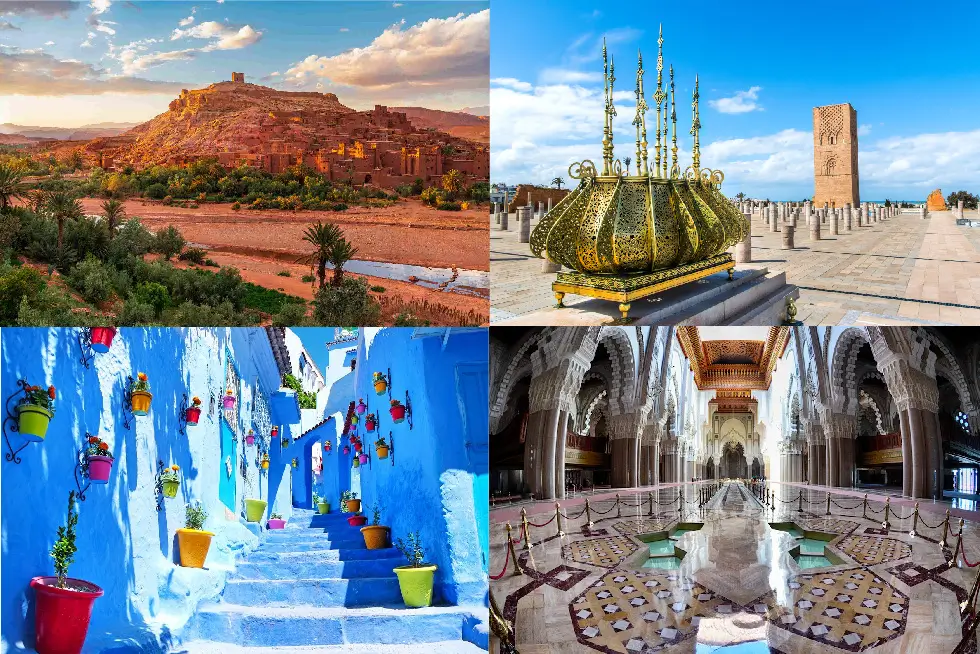
Table of Contents:
Introduction to Morocco
Morocco, officially known as the Kingdom of Morocco, its capital city Rabat, is a country with a rich history, diverse culture, and stunning natural landscapes, and it’s known for its Hospitality.
Situated in the northwestern corner of the African continent. It uniquely sits at the meeting point between the African and the European continents. Being separated from Spain in southern Europe by the narrow Strait of Gibraltar.
Its geographical location lends it between the Atlantic Ocean in the west and the Mediterranean Sea in the north, through the rugged Atlas Mountains, to the sweeping sands of the Sahara Desert in the far south.
This unique blend of geographical diversity, historical richness, and cultural vibrancy makes Morocco a fascinating country in North Africa, offering a blend of old-world charm and modern-day progress.
Exploring The Regional Diversity That Morocco Has
The regional diversity in Morocco can be explored through its 12 administrative regions and 75 cities, each with its own unique characteristics:
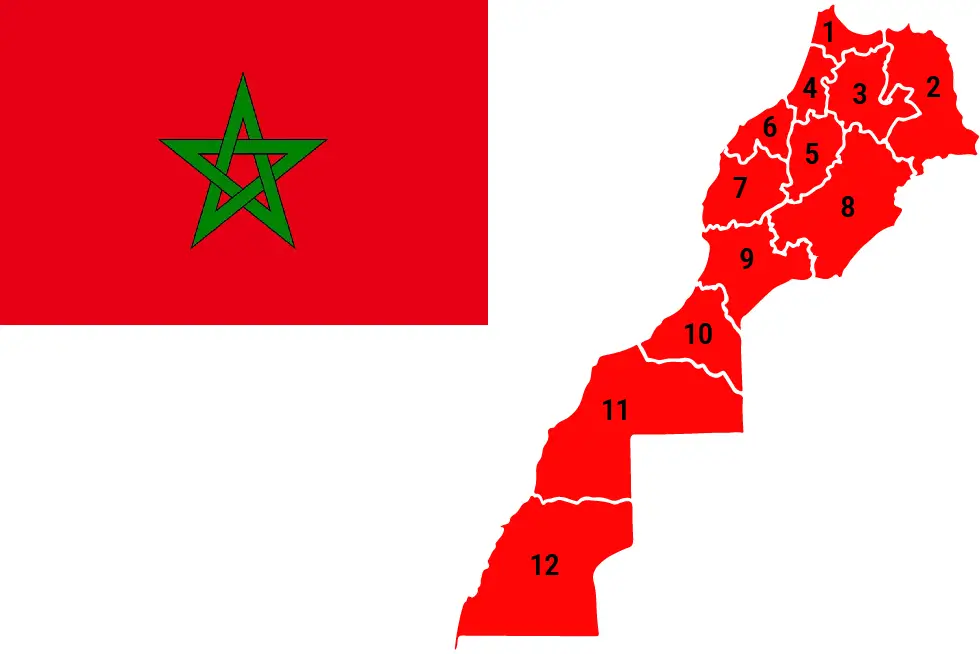
| N | Regions | Capitales | Cities |
|---|---|---|---|
| 1 | Tanger–Tétouan–Al Hoceima | Tanger – Assilah | Tangier, Assilah, M’diq, Fnideq, Tétouan, Fahs-Anjra, Larache, Al Hoceima, Chefchaouen, Ouazzane |
| 2 | L’Oriental | Oujda-Angad | Oujda, Nador, Driouch, Jerada, Berkane, Taourirt, Guercif, Figuig |
| 3 | Fès-Meknès | Fès | Fès, Meknès, El Hajeb, Ifrane, Moulay Yacoub, Sefrou, Boulemane, Taounate, Taza |
| 4 | Rabat–Salé–Kénitra | Rabat | Rabat, Salé, Skhirat, Témara, Kénitra, Khémisset, Sidi Kacem, Sidi Slimane |
| 5 | Beni Mellal–Khénifra | Béni Mellal | Béni Mellal, Azilal, Fquih Ben Salah, Khénifra, Khouribga |
| 6 | Casablanca-Settat | Casablanca | Casablanca, Mohammedia, El Jadida, Nouaceur, Médiouna, Benslimane, Berrechid, Settat, Sidi Bennour |
| 7 | Marrakech-Safi | Marrakech | Marrakech, Chichaoua, Al Haouz, Kelâa des Sraghna, Essaouira, Rehamna, Safi, Youssoufia |
| 8 | Drâa-Tafilalet | Errachidia | Errachidia, Ouarzazate, Midelt, Tinghir, Zagora |
| 9 | Souss-Massa | Agadir Ida-Ou-Tanane | Agadir, Inezgane, Aït Melloul, Chtouka-Aït Baha, Taroudannt, Tiznit, Tata |
| 10 | Guelmim-oued Noun | Guelmim | Guelmim, Assa-Zag, Tan-Tan, Sidi Ifni |
| 11 | Laâyoune-Sakia Al Hamra | Laâyoune | Laâyoune, Boujdour, Tarfaya, Es-Semara |
| 12 | Dakhla-Oued Eddahab | Oued Ed-Dahab | Oued Ed-Dahab, Aousserd |
Morocco is one of rich and diverse cultural and geographical landscapes, which is a blend of indigenous Berber, and Arab, among others.
The regional diversity is also reflected in the different varieties of languages spoken, like Arabic and Berber, and the variety of musical genres prevalent in different parts of the country.
Furthermore, Morocco’s geographical diversity plays a vital role in its regional uniqueness. The country’s location in the northwest corner of Africa, near Europe across the Strait of Gibraltar, has contributed to its blended culture from Arab, Berber, European, and African influences.
The Beautiful Natural Landscapes Of Morocco
Morocco’s diverse landscapes offer a visual feast for anyone who appreciates natural beauty. Here’s an overview of some of the prominent landscapes and unique flora and fauna found across different regions of Morocco:
Atlas Mountains

The High Atlas, often referred to as the “roof of Morocco,” is home to North Africa’s highest peak, Djbel Toubkal, which towers at 4,167 meters. Stretching over 750 kilometers, the Atlas Mountains create a natural separation between the Atlantic, Mediterranean, and Saharan regions of Morocco. These mountains are adorned with rich evergreen oak, cedar, and pine forests on their slopes.
Sahara Desert
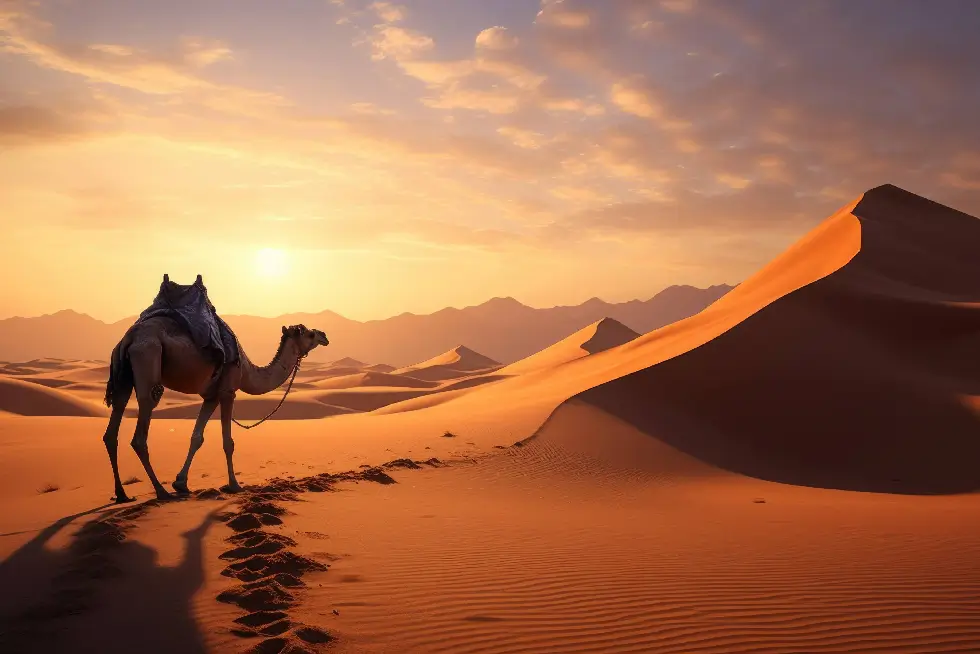
The vast expanse of the western Sahara Desert covers the southern part of Morocco, offering a stark contrast to the lush, mountainous regions. Here, you can find a variety of wildlife adapted to arid conditions, such as desert foxes, jackals, and various reptiles like lizards and snakes…
Mediterranean and Atlantic Coasts
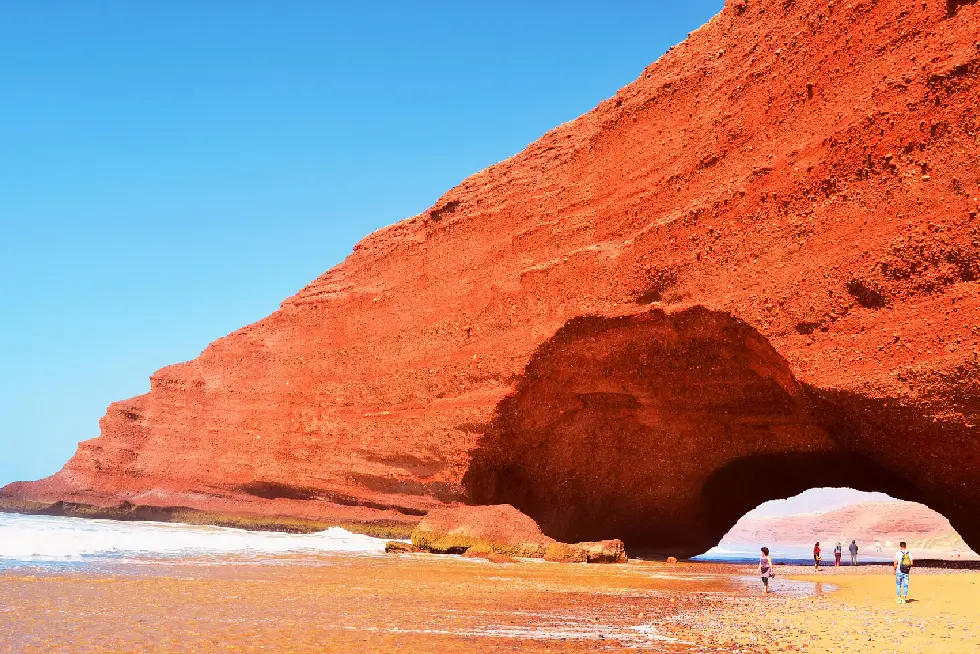
Morocco’s extensive coastline along the Mediterranean and Atlantic provides a haven for numerous species. The coastal areas boast a variety of flora, including extensive stands of cork oak. The Mediterranean climate supports a rich biodiversity, particularly in the wetlands, which are crucial habitats for migratory birds.
Iriqui National Park
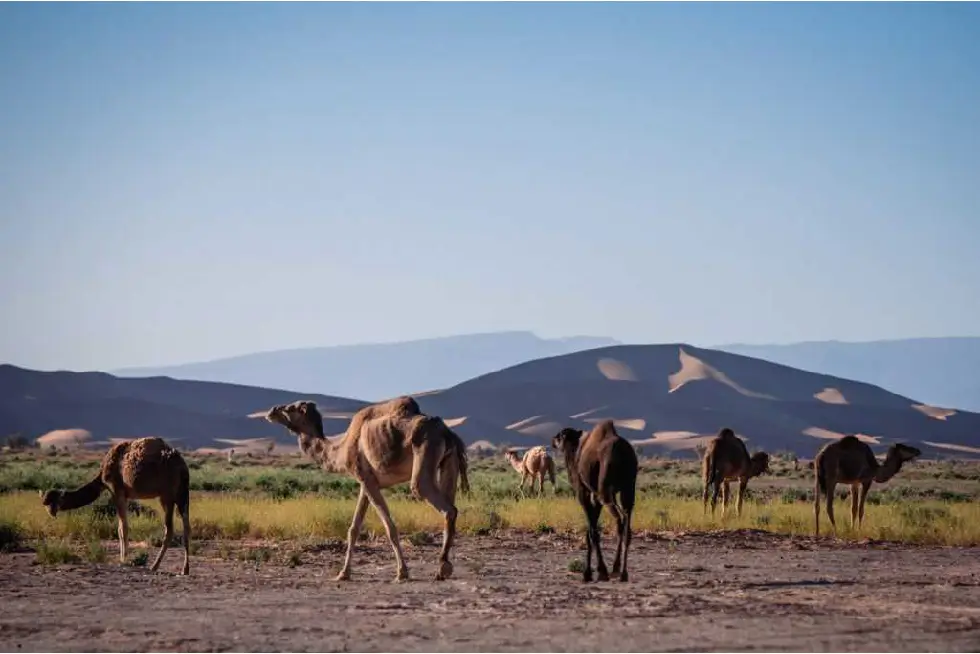
Iriqui National Park, Morocco’s largest national park, spans a landmass of 303,940 acres. It encapsulates a wild region of arid savanna, dunes, salt flats, and, notably, the ephemeral wetlands of Lake Iriqui, which attract migratory birds during the winter months.
Unique Flora and Fauna
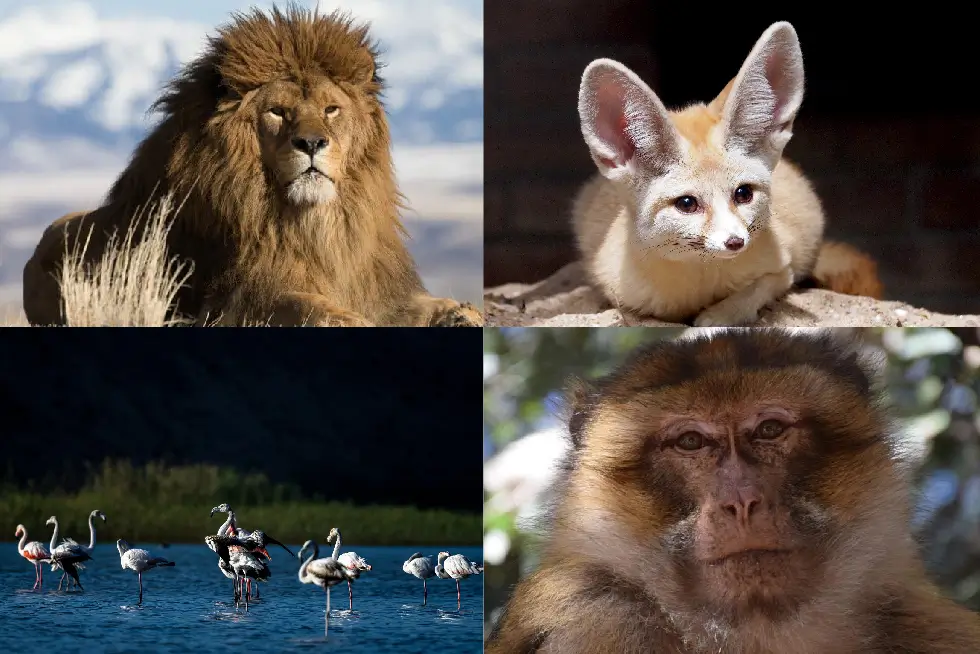
Morocco hosts about 3,900 species of plants, showcasing the country’s botanical diversity. The flora is a result of Morocco’s geographical location, which once acted as a land bridge between Africa and Europe. The fauna is equally diverse, with over 200 species of birds regularly breeding in Morocco. Other notable animals include the Barbary macaques, leopards, desert lynxes, and gazelles, each adapted to the country’s varied environments.
Other Notable Landscapes:
The Cedar Forests of the Middle Atlas
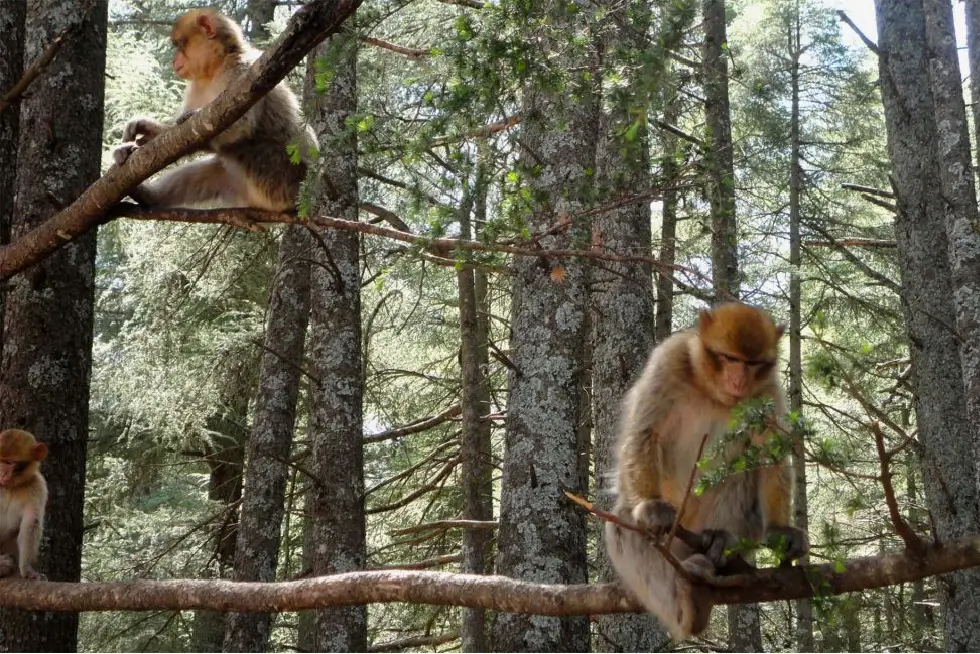
The Rif Mountains in the north

The Draa Valley, with its date palm oases and ancient kasbahs.
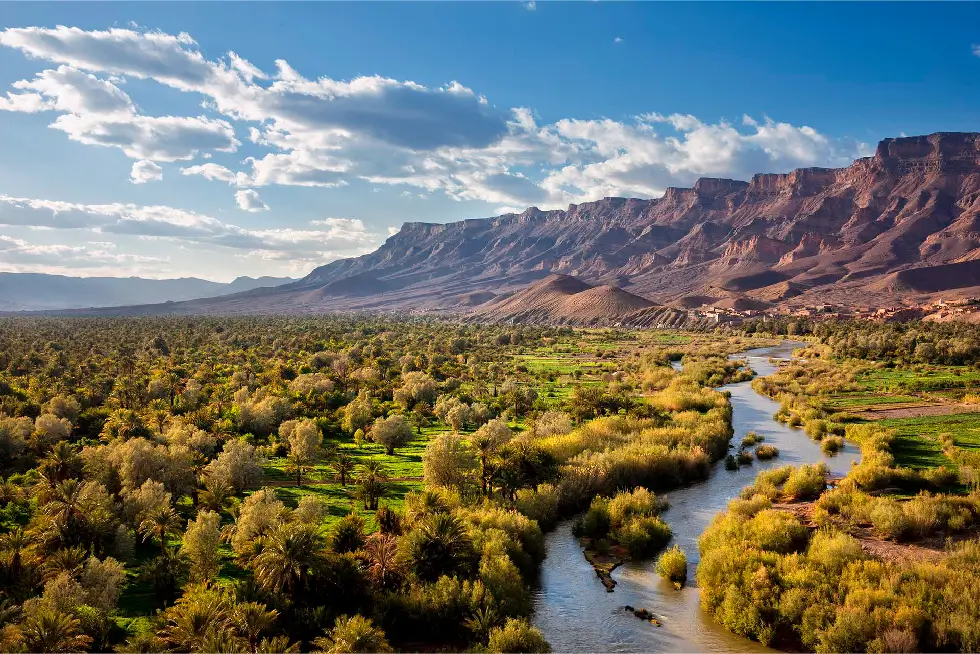
These landscapes not only offer a glimpse into the country’s ecological diversity but also provide a backdrop to the rich cultural heritage of Morocco.
Moroccan Cuisine, The Most Famous Traditional Food In Morocco
Moroccan cuisine, one of the most famous in the world, is a reflection of the rich cultural and historical influences that the country has embraced over centuries.
It’s a blend of Berber, Andalusi, Mediterranean, and Arab cuisines, with slight European and sub-Saharan touches, creating a unique and flavorful culinary identity. Here are a few traditional dishes that stand out as emblematic of Morocco’s culinary heritage:
Couscous

Recognized as Morocco’s national dish, Couscous is essential in Moroccan cuisine, particularly as a family staple during Friday lunches and comfort food for mourners.
Tajine
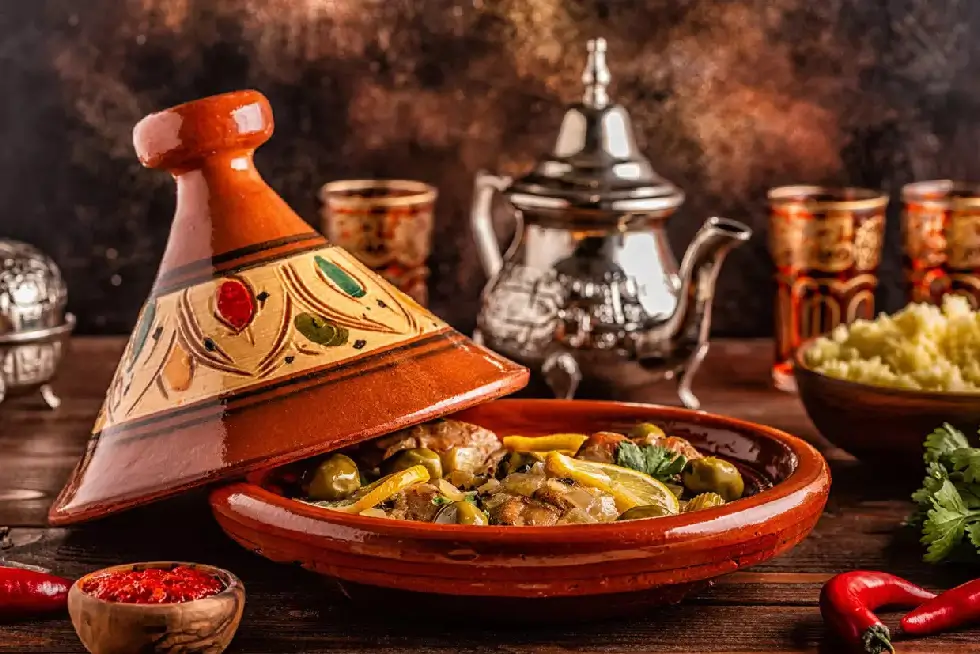
Tajine is a quintessential Moroccan stew, slow-cooked in a conical clay pot, also called a tajine, over coals.
Tanjia
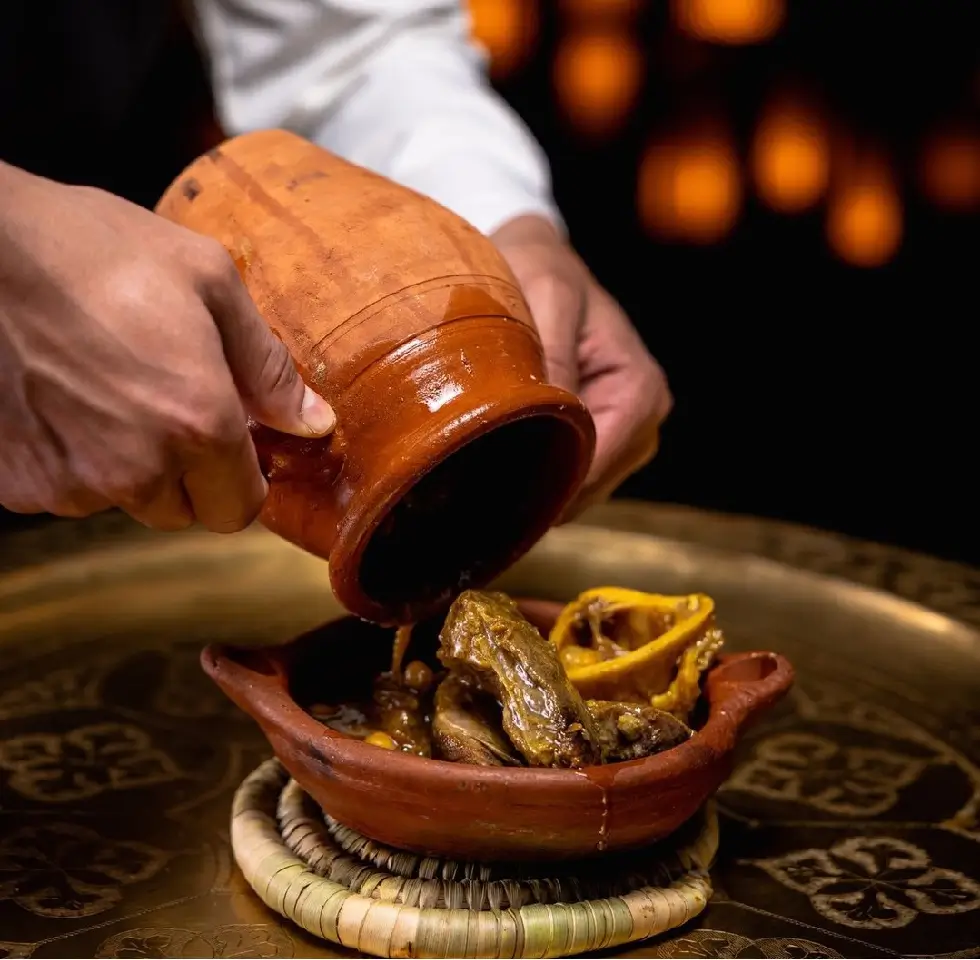
(not to be confused with Tajine), Tanjia is a special dish from Marrakech, traditionally prepared by slow-cooking lamb meat with spices such as saffron, cumin, garlic, lemons, and olive oil in a clay urn called Tanjia.
Pastilla

A savory-sweet pie traditionally made with pigeon meat, almonds, and spices, enclosed in layers of thin pastry dough called warqa. It’s a festive dish often served at weddings and other celebrations.
Harira
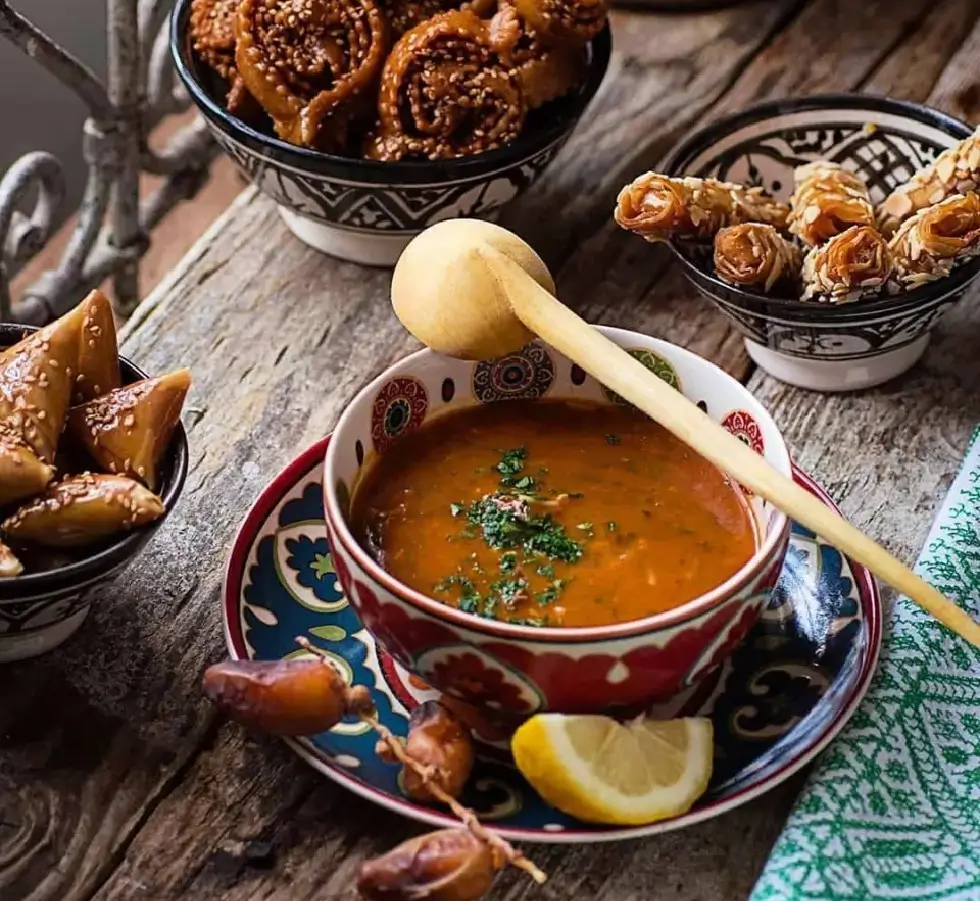
A hearty soup made with lentils, chickpeas, tomatoes, and meat, often enjoyed during the holy month of Ramadan to break the fast.
Mrouzia
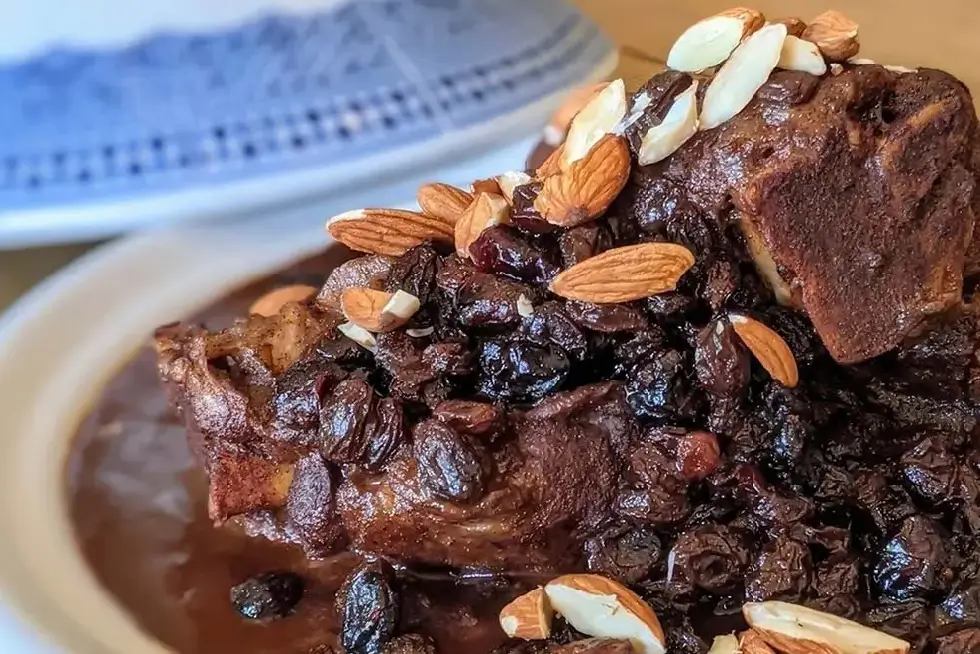
A sweet and savory tagine dish made with lamb, honey, almonds, and a blend of Moroccan spices known as Ras El Hanout.
Méchoui
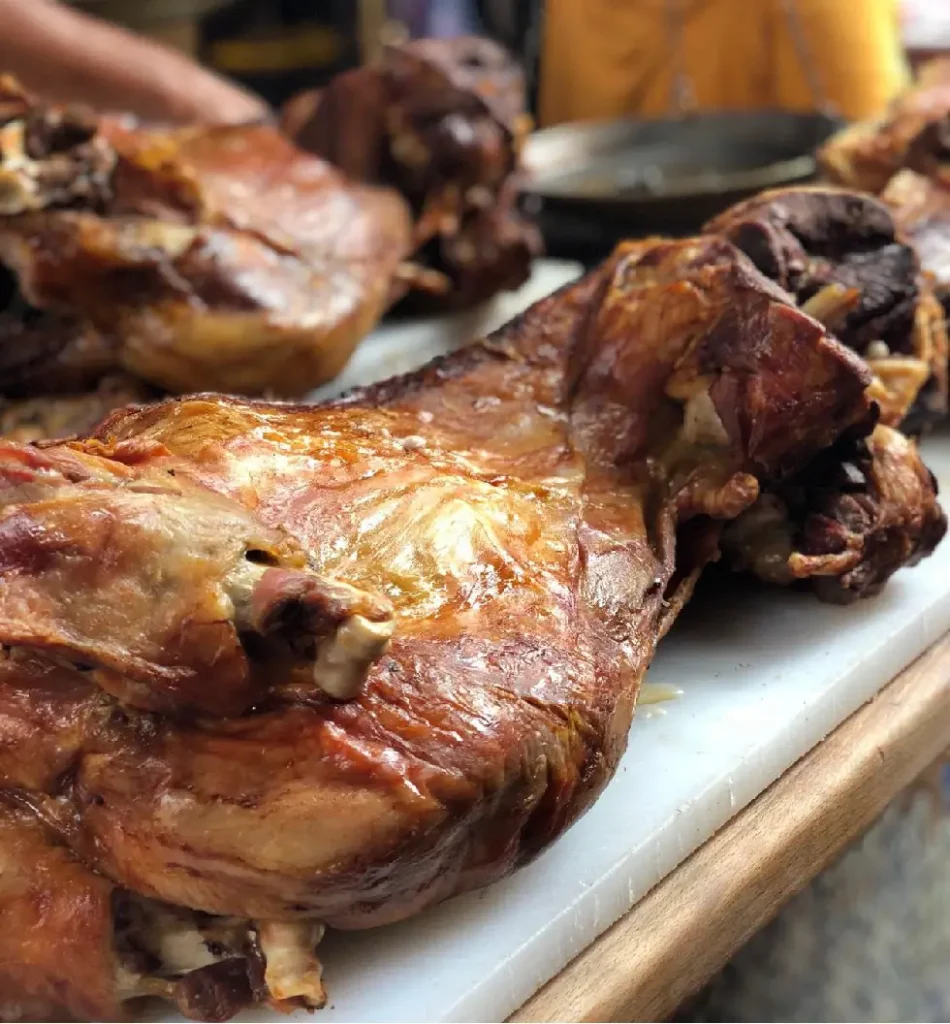
A dish of roasted lamb or beef, traditionally prepared in an underground oven, is a common choice for large gatherings or celebrations.
Rfissa

A traditional Moroccan dish made with shredded pancakes or bread, chicken, lentils, and a medley of herbs and spices.
Bread and pastries
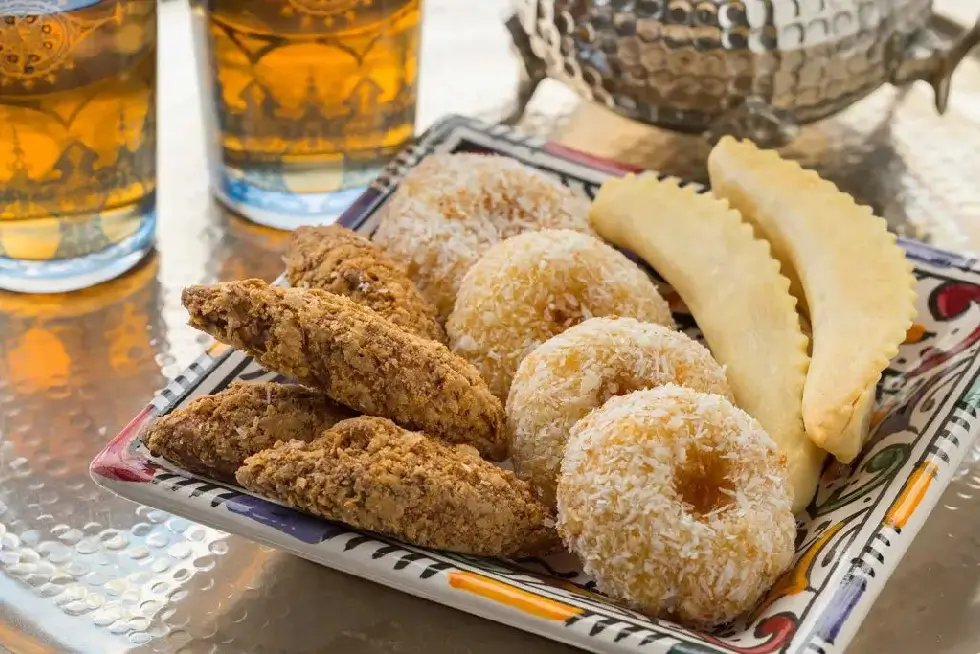
- Bread, particularly a round crusty bread known as Khobz, is a staple in Moroccan cuisine, often used as a utensil to scoop up meat and vegetables.
- Sweet pastries like Gazelle’s Horns (Kaab el Ghazal), and Chebakia (a sesame cookie) are also integral to Moroccan food culture.
Moroccan Tea Culture
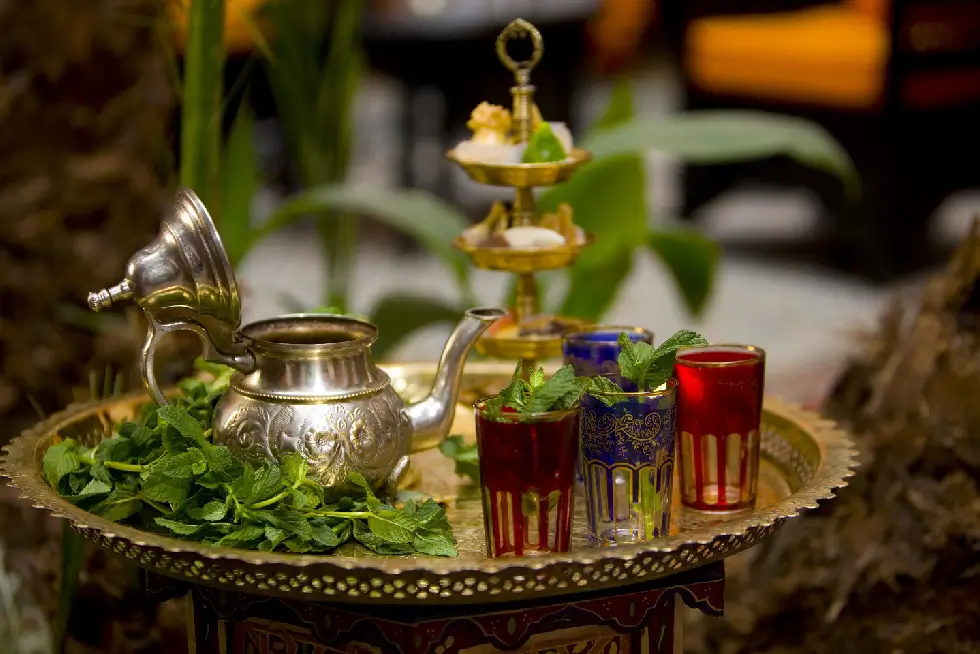
- Moroccan mint tea is a symbol of hospitality and is traditionally offered to guests as a sign of warm welcome. It’s made with green tea, fresh mint leaves, and a generous amount of sugar.
These examples are just a few of many, which reflect the diverse array of dishes, flavors, and customs that illustrate the rich culinary landscape of Morocco, highlighting the integral role food plays in its cultural identity.
Adventures And Activities To Do In Morocco
Morocco offers a rich tapestry of adventures and activities for travelers, thanks to its diverse landscapes and Historical sites encompassing mountains, deserts, and coastlines. Here are some of the adventures awaiting in Morocco:
Mountain adventures
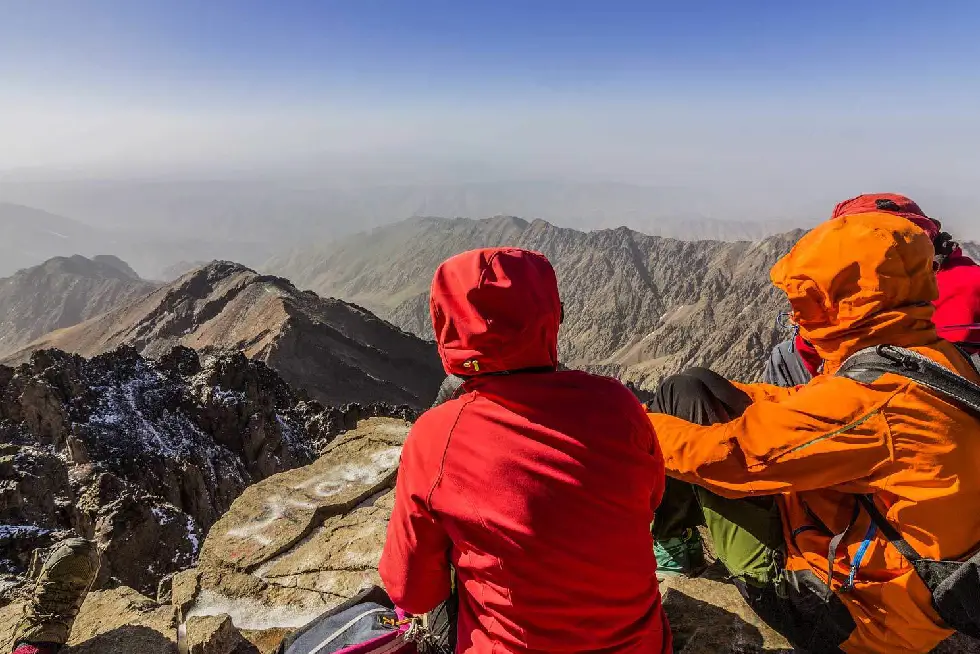
Hiking and Trekking: The Atlas Mountains offer breathtaking trails for hiking and trekking. Notable spots include the Draa Valley and the Anti-Atlas region.
Rock Climbing: Todra Gorge is a haven for rock climbing enthusiasts, boasting a narrow limestone canyon with walls reaching up to 1,312ft.
Winter Cross-Country Skiing: The Atlas Mountains also provide opportunities for winter cross-country skiing.
Desert Exploration

Camel Tours: Traverse the majestic Sahara Desert on a camel tour, embracing the endless sand dunes and exotic terrain.
Sandboarding: The huge dunes of Merzouga offer thrilling sandboarding adventures.
Water sports along the coast

Kite Surfing and Surfing: Known as the ‘Wind City of Africa’, Morocco’s Atlantic Coast is perfect for kite surfing and general surfing. The peak windsurfing season runs from April to November.
Canyoning: The Middle-Atlas region provides canyoning adventures for those seeking water-based thrills.
Exploration of Ancient Kasbahs
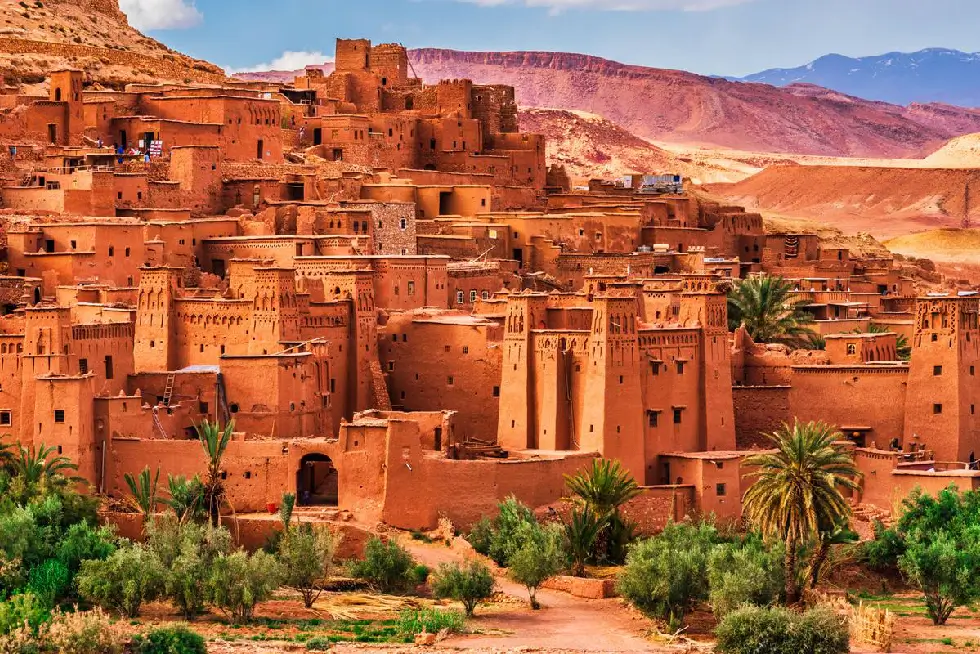
Morocco is home to ancient Kasbahs, traditional fortresses, that transport you back in time as you explore their historic corridors.
Other adventures
Mountain Biking: Mountain biking down the Draa Valley is another exhilarating adventure.
Horse Riding Along the Beach: The Moroccan coast offers idyllic settings for horse riding along the beach.
These diverse activities are just a few of many, that allow adventure-seekers to experience the natural wonders and cultural richness of Morocco from various exciting perspectives.
Ancient Moroccan Architecture
Ancient Moroccan architecture manifests a rich blend of Islamic, Berber, and foreign influences, reflecting the country’s multifaceted cultural heritage. The Islamic architectural tradition, emanating from the 7th century, brought forth iconic elements like the horseshoe arch and elaborate geometric designs, often seen in various structures like mosques and riads.
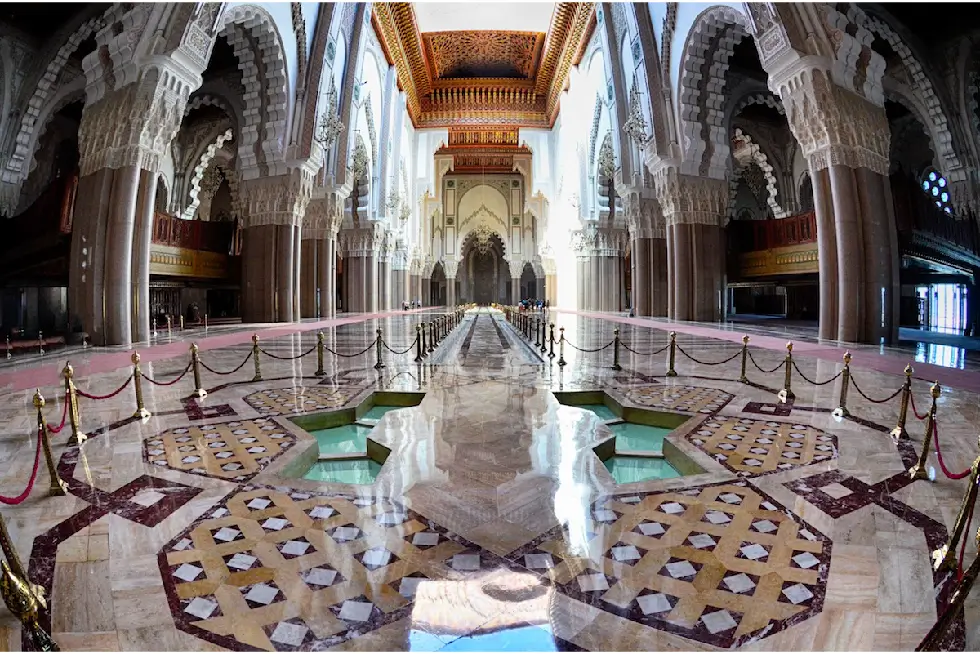
The indigenous Berber and Amazigh peoples contributed their unique styles, notably through mud-brick constructions and distinctive kasbahs and ksour (fortified villages) in rural regions. Ancient Roman influence also threads through Morocco’s architectural tapestry, dating back to 110 BCE with the Berber Kingdom of Mauretania.

These diverse architectural styles, intertwined with Morocco’s historical narrative, have crafted a unique architectural identity encapsulating mosques, riads, kasbahs, and various other traditional structures that continue to echo Morocco’s vibrant cultural lineage.
Traditional Moroccan Music
Traditional Moroccan music is rich and diverse, reflecting the country’s historical and cultural heritage. The musical styles vary significantly across different regions and social groups, infused with influences from Arabic, Berber, Andalusian, Mediterranean, Saharan, and West African traditions, among others.
Andalusi and malhun music

Andalusian music, known as Al-ALA, is a style most commonly associated with Morocco, particularly in urban centers in the northern part of the country. It evolved from the Arab-Andalusian classical tradition over a thousand years ago in Moorish Spain.
Malhun music is also associated with urban centers in the north and is often linked to the cities with historical connections to al-Andalus.
Chaabi and Aita
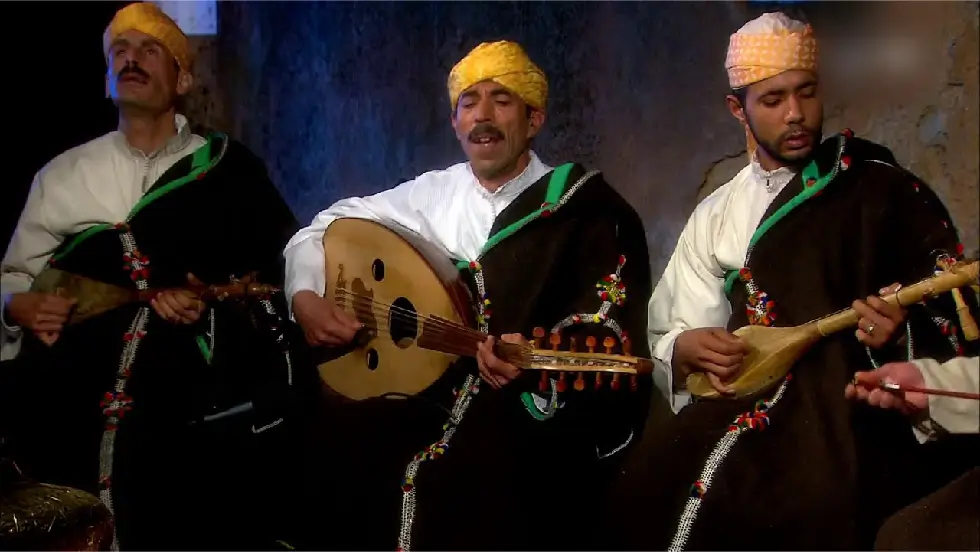
Chaabi and Aita are popular in the Atlantic coastal plains. Chaabi is a form of popular music while Aita is a genre of traditional Moroccan music often performed at weddings and other festivities.
Reggada

Reggada is a traditional music and dance form from the Beni-Znassen region, specifically associated with the city of Berkane and nearby villages. It’s the traditional music of the Amazigh people.
Gnawa

Gnawa music, rooted in sub-Saharan African traditions, is associated with the cities of Essaouira and Marrakech.
Ahidus and ahwash
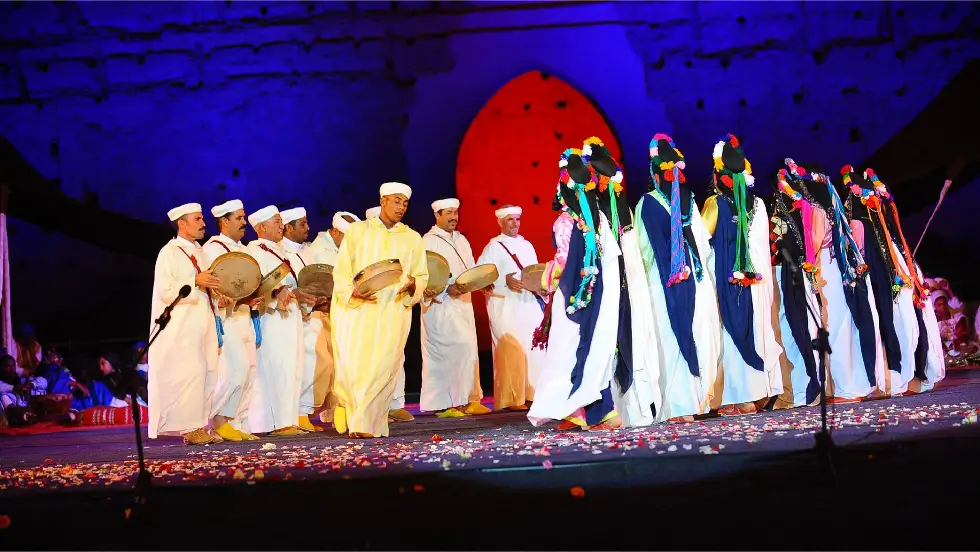
Ahidus is associated with the Middle Atlas, and Ahwash is associated with the Sous region. These are traditional Berber musical styles often performed in communal and celebratory settings.
Guedra:
Performed in the Sahara, Guedra is a traditional music and dance form that often accompanies a ritualistic dance known as the guedra dance.
Moroccan Traditional Crafts
Moroccan crafts are a rich blend of cultural traditions showcased through a variety of mediums, including pottery, leather goods, and textiles. Here’s a glimpse into each of these crafts:
Pottery

Moroccan pottery, often known for its colorful and ornate designs, is a longstanding tradition with roots in various regions of the country.
One notable style is the blue and white Fassi pottery from Fez, adorned with floral and balanced motifs. It’s handmade in the souks of Fez where visitors can observe potters at work and even try their hand at pottery-making. Additionally, the city of Safi is popular for its vibrant ceramics, which are sold locally and used for decoration in homes and restaurants across Morocco.
The pottery ranges from simple utility items like bowls and plates to more elaborate creations like vases and figurines.
Leather goods

Leatherwork has been a traditional craft in Morocco for centuries, with Moroccan leather products being recognized for their quality, durability, and intricate designs.
The unique vegetable tanning process used in Morocco, involving natural tannins from plants, gives the leather a distinct finish and a soft feel.
The city of Fez is particularly known for its traditional leather industry, with leatherwork being a common tradition in many Moroccan cities like Meknes, Marrakech, Rabat, Tetouan, and Tangier.
Textiles
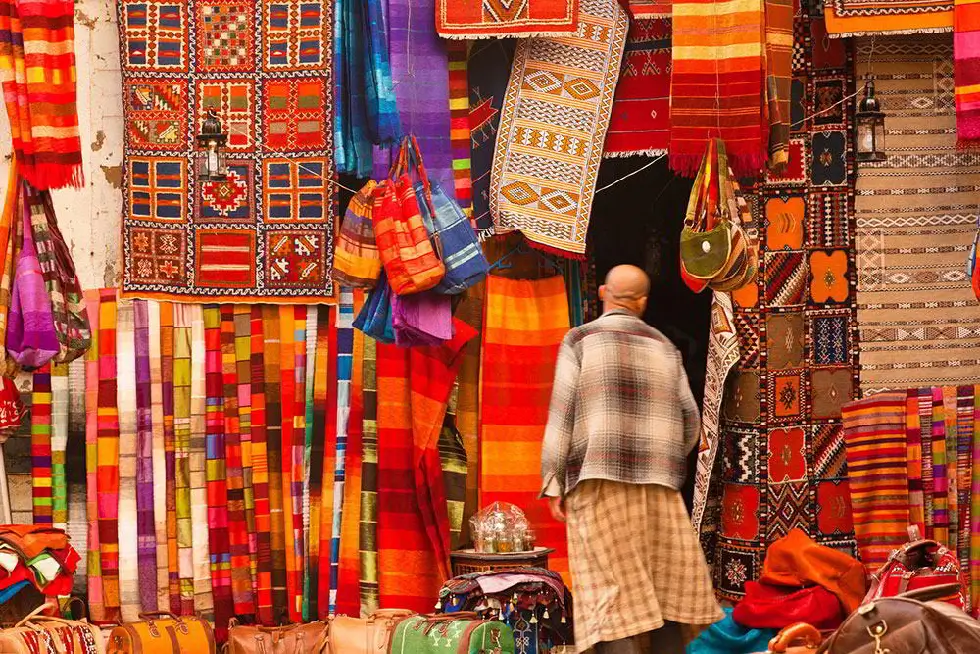
Textile craftsmanship in Morocco includes a wide array of products, often showcasing intricate patterns and vibrant colors.
Handmade rugs are one aspect of Moroccan textile artistry, which often feature complex patterns reflective of the country’s rich cultural heritage.
The aforementioned crafts reflect a blend of traditional techniques and cultural heritages that make Moroccan artisanal work highly valued and sought after globally.
Modern Morocco

Morocco has artfully balanced modernization with the preservation of its rich cultural heritage. Tradition is deeply ingrained in daily life, showcased through festivals, architecture, and crafts. On the flip side, Morocco has embraced modernization through technological advancements, renewable energy projects, and digital infrastructure improvements.

The thriving cultural tourism sector exemplifies a blend of tradition and modernity, attracting global engagement. Social cohesion is maintained by viewing tradition and modernity as complementary.

The discourse around language and religion further underscores this balance, amidst underlying political and ideological tensions. This balance positions Morocco as a unique example of how tradition and modernity can coexist and enrich each other.
Historical Overview Of Morocco
Morocco’s historical narrative commences around 400,000 years ago, marked by early habitation at Jebel Irhoud. The region was primarily inhabited by indigenous Berbers before encountering Phoenician colonization between the 8th and 6th centuries BCE
. Several ancient cities like Volubilis, Sala (Chellah), Lixus, Banasa, Ceuta, Melilla, and Tingis (now Tangiers) mark the landscape of Morocco.
Foundation and dynasties:
Berbers: Prior to external influences, indigenous Berber monarchs held sway from the 3rd century BCE until 40 CE, when the Romans annexed the region.
Arabs: The wave of Arab influence commenced around 788 CE with the Idrisid dynasty, heralding the establishment of the Moroccan state. This era transitioned through several dynasties including the Almoravids, Almohads, Merinids, and Saadians, culminating in the Alaouite dynasty from 1667, which continues to the present.
Cultural imprints:
Various civilizations including the Phoenicians, Carthaginians, and Romans left enduring imprints on Morocco. For instance, Roman influence is significantly noted with the annexation of Mauretania in 42 AD, a dominion lasting until the 5th century AD.
Ancient cities:
Among the relics of ancient times are cities like Volubilis, emblematic of Roman heritage. Each ancient city encapsulates a segment of Morocco’s layered historical narrative.
Cultural crossroad:
Situated at the juncture of Africa and Europe, Morocco emerged as a cultural crossroad, melding Arab, Amazigh, and Andalusian cultures with African, Hebraic, and Mediterranean influences. This confluence of cultures crafts a distinctive Moroccan identity, evolving over centuries.
Modern cities as cultural intersections:
Modern urban centers like Rabat and Casablanca exemplify Morocco’s historical trajectory, blending tradition with modernity, and underscore its historical position as a crossroad of cultures.
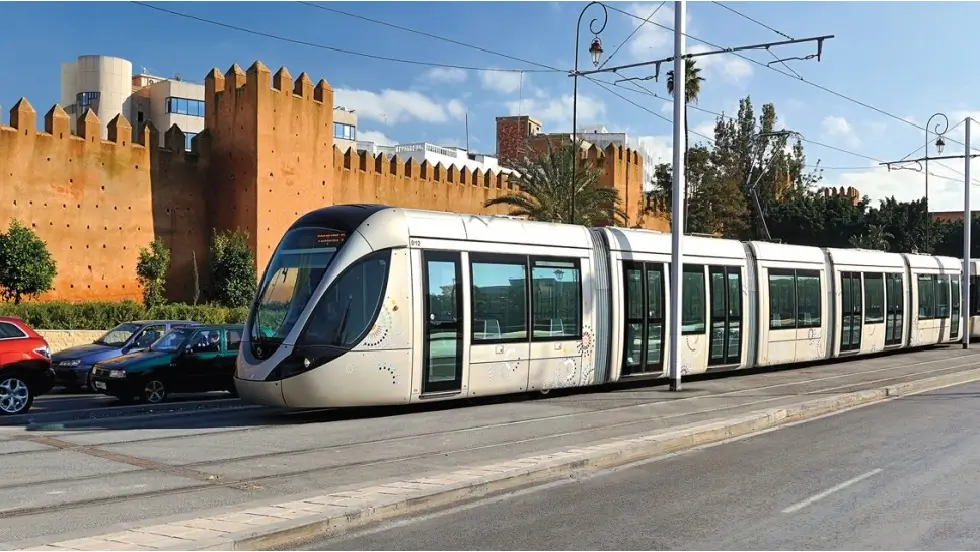
Morocco’s rich history serves as the backdrop against which it navigates the dichotomy of tradition and modernity, reflecting a kaleidoscope of cultural, political, and social dynamics sculpted over countless epochs.
Conclusion
I Encourage everybody to come visit and discover the enchanting country of Morocco, where diverse landscapes, rich culture, and historical wonders await. Morocco invites you to experience the hospitality of Moroccans, the majestic Moroccan western Sahara, the rugged Atlas Mountains, and serene coasts. Dive into a world where Arab, Berber, and European influences harmonize, offering a unique and vibrant cultural tapestry. Every region, a distinct gem, adds to the allure of this mesmerizing kingdom. Unravel the mystique of Morocco – a haven of diverse beauty and captivating traditions, waiting to be explored.
FAQ
What is the capital city of Morocco?
The capital city of Morocco is Rabat.
What is the location of Morocco?
Morocco is in North Africa, bordered by the Atlantic Ocean, the Mediterranean Sea, and Algeria. It’s near Europe, separated by the Strait of Gibraltar.
What is the highest mountain peak in Morocco?
Jbel Toubkal, located in the High Atlas Mountains of Morocco, is North Africa’s highest peak at 4,167 meters / 13,665 feet.
What is the language spoken in Morocco?
The official languages of Morocco are Arabic and Berber. Arabic is widely spoken in its Modern Standard form in official and formal settings, while a variety of Moroccan Arabic, known as Darija, is used in everyday communication. Berber, or Tamazight, has several dialects and is spoken by the Berber population in different regions of the country.
What are the popular traditional dishes of Moroccan cuisine?
Some traditional dishes include Couscous, Tajine, Tanjia, Pastilla, Harira, Mrouzia, Méchoui, Rfissa…
What adventures and activities can travelers do when visiting Morocco?
Some of what Travelers can enjoy are hiking and trekking in the Atlas Mountains, camel tours and sandboarding in the Sahara Desert, kite surfing on the Atlantic Coast, exploring ancient Kasbahs, and horse riding along the beach…
How does ancient Moroccan architecture reflect the country’s cultural heritage?
It’s a blend of Islamic, Berber, and foreign influences seen in mosques, riads, kasbahs, and other traditional structures.
What are the types of traditional Moroccan music?
Traditional Moroccan music includes Andalusi and malhun music, Chaabi and Aita, Reggada, Gnawa, Ahidus and ahwash, and Guedra.
How has modern Morocco balanced tradition and modernity?
Morocco has embraced modernization in technology, renewable energy, and digital infrastructure while preserving its cultural heritage in festivals, architecture, and crafts.
What is the historical significance of cities like Volubilis and Sala in Morocco?
These ancient cities, along with others, are relics from times when Morocco was influenced and occupied by various civilizations like the Phoenicians, Carthaginians, and Romans, each leaving enduring imprints on the country’s culture and architecture.
How many administrative regions are there in Morocco and what is their significance?
Morocco is divided into 12 administrative regions, each showcasing unique characteristics influenced by the country’s geographical and cultural diversity.
How is the Moroccan tea culture significant?
Moroccan mint tea is a symbol of hospitality and is traditionally offered to guests as a sign of a warm welcome.
What is unique about Morocco’s Iriqui National Park?
Iriqui National Park is Morocco’s largest, featuring arid savanna, dunes, salt flats, and the ephemeral wetlands of Lake Iriqui which attract migratory birds during winter.
What are some examples of Moroccan traditional crafts?
Moroccan crafts include pottery, known for its colorful and ornate designs; leather goods, recognized for quality and intricate designs; and textiles, featuring vibrant colors and complex patterns.


